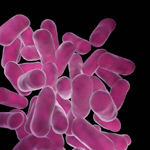Lactobacillus casei
A Microbial Biorealm page on the genus Lactobacillus casei
Classification
Higher order taxa
Bacteria; Firmicutes; Bacilli; Lactobacillales; Lactobacillaceae; Lactobacillus
Species
|
NCBI: Taxonomy |
Lactobacillus casei
Strains
Listed are some of the many strains/isolates of Lactobacillus casei:
HUMAN origin: L3, L6, L9, L14, L19, L25, L30, CRF28, Shirota
CHEESE origin: ASCC 428, ASCC 477, ASCC 1087, ASCC 1088, ASCC 1123, DPC 3971, DPC 3968, DPC 4249, DPC 4748
PLANT origin: 12A, 32G, BI0231, USDA-P
Description and significance
Describe the appearance, habitat, etc. of the organism, and why it is important enough to have its genome sequenced. Describe how and where it was isolated. Include a picture or two (with sources) if you can find them.
Genome structure
Describe the size and content of the genome. How many chromosomes? Circular or linear? Other interesting features? What is known about its sequence? Does it have any plasmids? Are they important to the organism's lifestyle?
Cell structure and metabolism
Describe any interesting features and/or cell structures; how it gains energy; what important molecules it produces.
Ecology
Describe any interactions with other organisms (included eukaryotes), contributions to the environment, effect on environment, etc.
Pathology
How does this organism cause disease? Human, animal, plant hosts? Virulence factors, as well as patient symptoms.
Application to Biotechnology
Does this organism produce any useful compounds or enzymes? What are they and how are they used?
Current Research
Enter summaries of the most recent research here--at least three required
References
1. Cai, H., Rodriguez, B.T., Zhang, W., Broadbent, J.R., and Steele, J.L. “Genotypic and phenotypic characterization of Lactobacillus casei strains isolated from different ecological niches suggests frequent recombination and niche specificity”. Microbiology. 2007. Volume 153. p. 2655-2665.
2. Chan-Blanco,Y., Bonilla-Leiva, A.R., and Velazquez, A.C. “Using banana to generate lactic acid through batch process fermentation”. Applied Microbiology Biotechnology. 2003. Volume 63. p. 147-152.
3. Desai, A.R., Shah, N.P., and Powell, I.B. “Discrimination of Dairy Industry Isolates of the Lactobacillus casei group”. Journal of Dairy Science. 2006. Volume 89. p. 3345-3351.
4. Ha, M.Y., Kim, S.W., Lee, Y.W., Kim, M.Y., and Kim, S.J. "Kinetics analysis of growth and lactic acid production in pH-controlled batch cultures of Lactobacillus casei KH-1 using yeast extract/corn steep liquor/glucose medium. Journal of Bioscience and Bioengineering. 2003. Volume 96. p. 134-140.
5. Holzapfel, W.H., Haberer, P., Geisen, R., Bjorkroth, J., and Schillinger, U. “Taxonomy and important features of probiotic microorganisms in food and nutrition”. The American Journal of Clinical Nutrition. 2001. Volume 73. p. 365S-373S.
6. Marcos, A., Warnberg, J., Nova, E., Gomez, S., Alvarez, A., Alvarez, R., Mateos, J.A., and Cobo, J.M. “The effect of milk fermented by yogurt cultures plus Lactobacillus casei DN-114001 on the immune response of subjects under academic examination stress”. European Journal of Nutrition. 2004. Volume 43. p. 381-389.
7. Millette, M., Luquet, F.M., and Lacroix, M. "In vitro growth of selected pathogens by Lactobacillus acidophilus- and Lactobacillus casei- fermented milk". Letters in Applied Microbiology. 2007. Volume 44. p. 314-319.
8. Mishra, V. and Prasad, D.N. “Application of in vitro methods for selection of Lactobacillus casei strains as potential probiotics”. International Journal of Food Microbiology. 2005. Volume 103. p. 109-115.
9. Nebesny, E., Zyzelewicz, D., Motyl, I., and Libudzisz, Z. "Dark chocolates supplemented with Lactobacillus strains". European Food Resource Technology. 2007. Volume 225. p. 33-42.
10. Salvatore, S., Hauser, B., Devreker, T., Vierira, M.C., Luini, C., Arrigo, S., Nespoli, L., and Vandeplas, Y. “Probiotics and zinc in acute infectious gastroenteritis in children: are they effective?”. Nutrition. 2007. Volume 23. p. 498-506.
11. Sauvageot, N., Beaufils, S., Maze, A., Deutscher, J., and Hartke, A. “Cloning and characterization of a gene encoding a cold-shock protein in Lactobacillus casei”. FEMS Microbiology Letters. 2006. Volume 254. p. 55-62. 12. Takeda, K. and Okumura, K. “Effects of a fermented milk drink containing Lactobacillus casei strain Shirota on the human NK-cell activity”. The Journal of Nutrition. 2007. Volume 137. p. 791S-793S.
12. Takeda, K. and Okumura, K. “Effects of a fermented milk drink containing Lactobacillus casei strain Shirota on the human NK-cell activity”. The Journal of Nutrition. 2007. Volume 137. p. 791S-793S.
13. Ventura, M., Canchaya, C., Bernini, V., Altermann, E., Barrangou, R., McGrath, S., Claesson, M.J., Li, Y., Leahy, S., Walker, C.D., Zink, R., Neviani, E., Steele, J., Broadbent, J., Klaenhammer, T.R., Fitzgerald, G.F., O’Toole, P.W., and van Sinderen, D. “Comparative genomics and transcriptional analysis of prophages identified in the genomes of Lactobacillus gasseri, Lactobacillus salivarius, and Lactobacillus casei”. Applied and Environmental Microbiology. 2006. Volume 72. p. 3130-3146.
14. Yoon, K.Y., Woodams, E.E., and Hang, Y.D. “Production of probiotic cabbage juice by lactic acid bacteria”. Bioresource Technology. 2006. Volume 97. p. 1427-1430.
Edited by Alison Wong, student of Rachel Larsen

